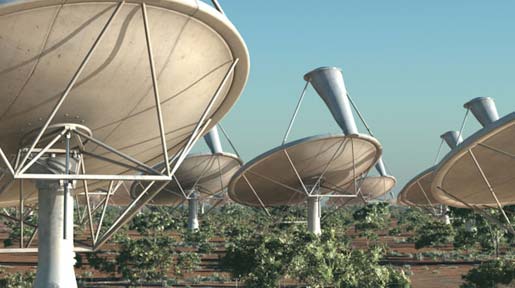Twenty industrialised nations are planning to work together to build an extremely powerful telescope called the Square Kilometer Array (SKA). It's going to be a radio telescope, the world's largest. The component aerials making up the square kilometer will span over 3,000km in length.
The resulting array will be 50
times more sensitive than any currently existing radio device and
10,000 times faster. This will result in a lot of data being produced,
estimated to be twice the
equivalent of today's entire internet
traffic (or 15 million full 64Gb iPods), in one day! The SKA is
intended to probe emerging galaxies, look into dark matter
and study remnants of the Big Bang which occurred 13 billion years ago.
The project, called DOME, is a collaboration between IBM and ASTRON, the Netherlands Institute for Radio Astronomy. The cost will be comparable to that needed to develop CERN, about $44 million initially.
All the data generated would be too much for today's computer systems to handle so IBM is researching new exascale computer systems that will be able to cope with the extreme amount of data storage, data transfer and analysis. It would be unacceptable to use current technology with it's power requirements, the new systems have to be beyond the current state-of-the-art. “We have to invent futuristic technology to look into the past,” Ronald Luijten, IBM’s lead researcher on the project in Zurich, Switzerland, said in an interview. “The energy issue is becoming ubiquitous. We need fundamental new technologies to deal with the needs of the future data centres.”
A prototype using high performance and low power signal processing chips has been made and IBM and ASTRON have collaborated before. Through experience they are sure the project goals, though ambitious, can be achieved; utilising green supercomputing, 3D stacked chips and optical connections.

The construction phase is estimated to start in 2017 and finish in 2024, the dishes will be positioned in either South Africa or Australia, subject to survey. The specialised software on the IBM designed exascale computers is being developed collaboratively with governments and universities.

One day, hopefully, we will find the answers we are looking for, and also we will have the exascale technology and innovations learned during this project utilised in making the world a better place (and also in our PlayStations).






